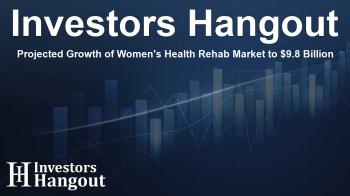Projected Growth of Women's Health Rehab Market to $9.8 Billion

Overview of Women’s Health Rehabilitation Products Market
The Women's Health Rehabilitation Products market is gaining significant traction, with projections indicating a rise to approximately USD 9.8 billion by 2034. This growth is driven by the rising awareness of women's health issues, technological advancements, and an aging female population. The industry is characterized by a variety of products, including orthopedic supports, pelvic health devices, postpartum recovery tools, and breast cancer rehabilitation products, catering to a wide array of needs.
Market Drivers and Trends
Increased Demand for Specialized Health Products
One of the major factors fueling the demand for women’s health rehabilitation products is the increased public awareness of issues such as pelvic floor disorders and postoperative care. As more women become educated about their health, the need for specialized rehabilitation products expands alongside it. Campaigns aimed at women’s health are playing a pivotal role in enhancing preventative and rehabilitative care.
Aging Population and its Impact
As the global population ages, the need for orthopedic and rehabilitation support grows. Women, particularly those over 65, often experience conditions that necessitate the use of mobility aids and physical therapy devices. This demographic shift indicates a rising demand for innovative and accessible rehabilitation solutions tailored to women's health.
Technological Developments
Advancements in technology are rapidly transforming the healthcare landscape. Smart rehabilitation devices and digital health solutions are enhancing patient monitoring and compliance, enabling women to manage their health more effectively at home. These innovations are critical in reducing healthcare costs while improving recovery outcomes.
Segmentation by Product Types
The market is segmented into various product types that address specific health concerns:
- Orthopedic supports
- Pelvic floor and pelvic health devices
- Postpartum and post-surgical recovery tools
- Breast cancer rehabilitation products
- Mobility and physical therapy devices
- Other rehabilitation products
Regional Insights
Geographically, the Women’s Health Rehabilitation Products market is delineated into several critical regions, each showcasing unique drivers of growth:
North America
This region is a leader in the adoption of healthcare products driven by advanced medical infrastructure and awareness programs. The demand for eco-friendly products is also on the rise as healthcare facilities look for sustainable solutions.
Europe
In Europe, stringent regulations and increased healthcare spending make the market favorable for innovations in women's health rehabilitation technologies. Consumers show a growing preference for environmentally safe medical products.
Asia-Pacific
The Asia-Pacific region is the fastest-growing market, attributed to increasing disposable incomes and investments in healthcare. Countries such as India and China are witnessing a surge in demand for affordable and effective rehabilitation solutions.
Competitive Landscape
Several key players dominate the Women’s Health Rehabilitation Products market, including notable companies committed to innovation and patient care improvements. These companies continually engage in research and development to enhance the effectiveness and comfort of their products, ultimately improving women's health outcomes.
Conclusion
In summary, the Women's Health Rehabilitation Products market is on a positive trajectory toward substantial growth by 2034. This expansion is underpinned by a confluence of factors, including awareness initiatives, technological advancements, and demographic trends. The active engagement of industry leaders in innovating and delivering powerful solutions will significantly shape the future of women's health rehabilitation.
Frequently Asked Questions
What is the current size of the Women's Health Rehabilitation Products market?
The market is currently valued at approximately USD 5.2 billion and is anticipated to reach around USD 9.8 billion by 2034.
What are the main drivers of growth in this market?
Key drivers include increased awareness of women's health issues, technological advancements, and the aging female population requiring specialized care.
What types of products are included in this market?
The market includes orthopedic supports, pelvic health devices, postpartum recovery tools, and more, addressing a variety of rehabilitation needs.
Which regions are growing in this market?
North America, Europe, and Asia-Pacific are prominent regions witnessing rapid growth in the women's health rehabilitation sector.
Who are the key players in the Women's Health Rehabilitation Products market?
Key players include major healthcare companies focused on innovation and the delivery of effective rehabilitation solutions for women.
About The Author
Contact Caleb Price privately here. Or send an email with ATTN: Caleb Price as the subject to contact@investorshangout.com.
About Investors Hangout
Investors Hangout is a leading online stock forum for financial discussion and learning, offering a wide range of free tools and resources. It draws in traders of all levels, who exchange market knowledge, investigate trading tactics, and keep an eye on industry developments in real time. Featuring financial articles, stock message boards, quotes, charts, company profiles, and live news updates. Through cooperative learning and a wealth of informational resources, it helps users from novices creating their first portfolios to experts honing their techniques. Join Investors Hangout today: https://investorshangout.com/
The content of this article is based on factual, publicly available information and does not represent legal, financial, or investment advice. Investors Hangout does not offer financial advice, and the author is not a licensed financial advisor. Consult a qualified advisor before making any financial or investment decisions based on this article. This article should not be considered advice to purchase, sell, or hold any securities or other investments. If any of the material provided here is inaccurate, please contact us for corrections.

